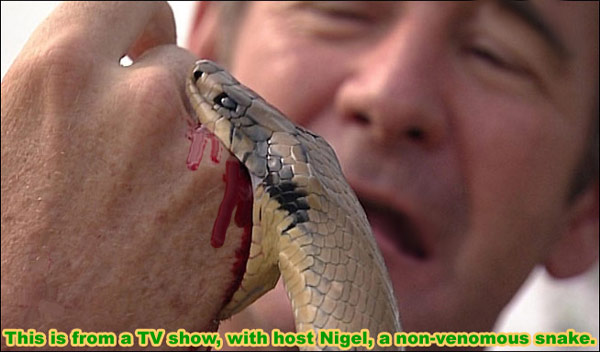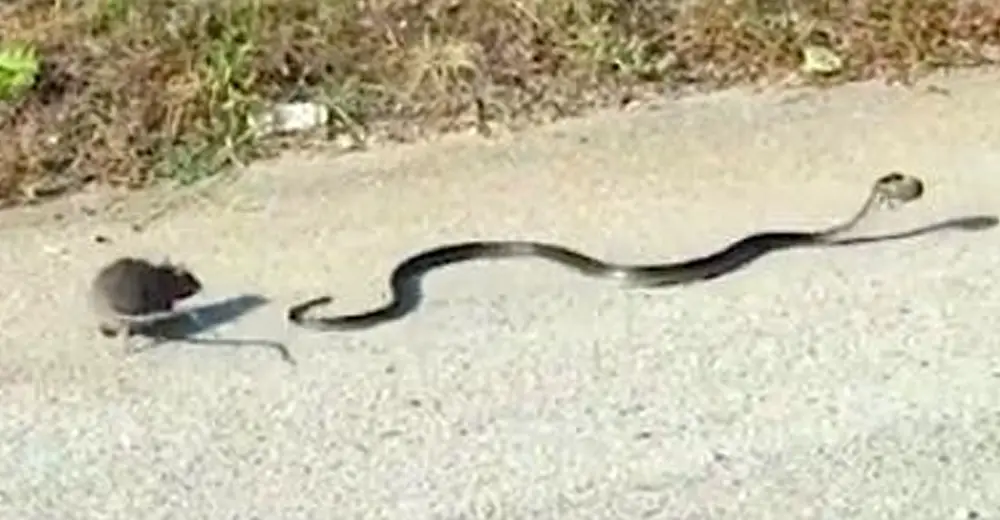-
Gallery of Images:

-
A venomous (poisonous) snake bite is a bite or a puncture wound made by a snake that is capable of injecting, secreting, or spitting a toxin into the penetrated skin wound or, mucus membranes or the eyes where the toxin can be absorbed. In North America, there are about 25 species of snakes able to secrete toxin. However, nonnative poisonous species are present in zoos and held in private. The worlds largest venomous snake is the king cobra, or hamadryad (Ophiophagus hannah). Found predominantly in forests from India through Southeast Asia to the Philippines and Indonesia, it preys chiefly on other snakes. Snake Island is home to 2, 000 deadly golden lancehead vipers. The island is the only place this particular species exists. The Pit Vipers Snake Facts Photos. Pit vipers are some of the most beautiful, and most dangerous, snakes in the world. They exist on several different continents, and within a wide variety of habitats. Photo by Matthijs Hollanders Queen Snake Regina septemvittata. Common Name Queen Snake Snake venom is highly modified saliva containing zootoxins which facilitates the immobilization and digestion of prey, and defense against threats. It is injected by unique fangs after a bite, and some species are also able to spit their venom. The glands that secrete the zootoxins are a modification of the parotid salivary gland found in other vertebrates, and are usually situated on each. Snake Pictures Poisonous Snakes of the United States. Poisonous Snake Index Pictures of Snakes. Repelling Snakes Trapping Snakes. This page contains pictures of the poisonous snakes found in. All you ever wanted to know and some things you did not. Copperhead snakes are pit vipers or crotalids (family Crotalidae); poisonous snakes that are named for the two heat sensing pits used to locate prey that. SNAKE BITES Poisonous and nonpoisonous snakes are widely distributed throughout the United States. In general, bites of nonpoisonous snakes do not cause swelling or pain. The biggest concern from snake bites, including the nonvenomous ones, is infections at the site of the bite. That is also the case with any pets. Most snake bites are from pit vipers, which are poisonous snakes that are identified by their triangular heads, retractable fangs, and a special heatsensing pit. The Brown Snake Complex Genus Pseudonaja formally Demansia All Brown Snakes are egg layers not live bearers and all but one species the Ringed Brown (Pseudonaja modesta) should be classed as deadly. Specific antivenom is Brown snake antivenom. Snakebite (Snake Bite) Poisoning. The venom from a snakebite is poisonous. Poison is a toxin that kills or injures the body's tissues and organs through its chemical actions. An Identification Guide for North Texas Snakes There are many species of snakes living in north Texas, and most of them are harmless. A snakebite is an injury caused by the bite of a snake, especially a venomous snake. A common symptom of a bite from a venomous snake is the presence of two puncture wounds from the animal's fangs. Sometimes venom injection from the bite may occur. This may result in redness, swelling, and severe pain at the area, which may take up to an hour to appear. Beside the Eastern Coral Snake there are two other banded, red, yellow, and black snakes in Florida. Two of them mimic the one that is dangerous in the hope they will be left alone by predators. Copperhead snakes are some of the more commonly seen North American snakes. They're also the most likely to bite, although their venom is relatively mild, and their bites are rarely fatal for humans. Snake venoms are made up of various types of proteins that work in different ways throughout the body. The North American pit vipers venom damages the lining of blood vessels and lymphatic system (which includes the lymph nodes, spleen, and bone marrow). Venom from copperheads is not deadly, and when people die from copperhead snake bites it is due to an allergic reaction. People who are weak or either very old or very young may experience a significant impact on their body functions from a copperhead snake bite. The Keelback is one of the only native animals that is able to eat Cane Toads without ill effect. This species is very similar in appearance to the Rough Scaled snake which is highly venomous and has overlapping distribution..
-
Related Images:











